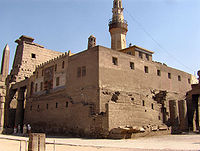- Abu Haggag Mosque
-
The Mosque of Abu Haggag (Arabic: جامع أبو الحجاج بالأقصر) is a mosque located in the Egyptian city of Luxor. Specifically, it stands atop the ruins of Luxor Temple, an Ancient Egyptian centre of worship dating back to the reign of Pharaoh Amenhotep III in the 14th century BC.
History
Although its positioning atop the pharaonic columns seems both precarious and invasive, the Mosque of Abu Haggag (or Abu l-Haggag) must be seen as more than just a coincidental intruder. First, when the mosque was built, large parts of the temple were covered with earth. Secondly, it is not uncommon for a religious kinship between ancient Egyptian cult places and the local version of popular Islam to be recreated. When the pharaonic temple was unearthed in the late 19th century, locals fiercely resisted any attempt to tear down the mosque. For them, the geographical position was important, and a new mosque also dedicated to Abu Haggag has never become very popular.
Abu Haggag was a Sufi shaykh, born in Baghdad, but he spent the latter half of his 90 years in Luxor. He died here in 1243, but it is believed that the minaret is older than he was, dating back to the 11th century. The mosque itself has been rebuilt many times, and completely in the 19th century. Abu Haggag is Luxor's main saint, and his mosque is the core of local religious activities. Locals believe that his mosque is a particularly important religious spot, full of baraka, divine blessing.
When Shaikh Abu El Haggag came to Luxor, Islam at the time was not the major religion in Egypt; Coptic Christianity was the leading religion at the time. The city was a colony owned by a religious Coptic lady. She used to be called The Princess. Her soldiers saw Sheikh Abu El Haggag there and was immediately recognized as a foreigner, therefore he was taken to the Princess for questioning as they feared that he is a spy from a different tribe/region. He complained to her about the treatment he received and expressed that he wishes to become a local citizen. The lady was generous and offered him to stay as long as he wishes. He asked her to give him a land as big as a camel’s skin to sleep on it, she thought that would be maximum of 2 square meters, so she agreed as she was a generous Lady, he asked her to sign a contract confirming the deal which she agreed to.
At night, he took a camel’s skin and he cut it into a very thin line at the front of some local witnesses, something similar to a very thin washing line, he used it to border a big part of Luxor Temple. In the morning, soldiers saw this line and reported it to the Princess, and then she realised that he owns this bordered part of the temple as per their written agreement. As much as she was feeling deceived by his plan, they met few times afterwards, she was impressed by his knowledge and then she converted to Islam.
At the time, there was a church in the place of the mosque. Shaikh Abu El Haggag agreed with the princess to convert the building to a mosque, which stands till today. In the upper ground foundation the old part of the church, which is clear that it is not a part of the temple, can still be seen.
Lots of people claimed that he became a monk and was given a power to practice miracles, such as walking on water, healing rare diseases, and even people see him in the pilgrimage in Saudi Arabia while others sees him at the same time in Luxor. When he died he was buried in the mosque.
External links
 Abu Haggag Mosque• Amr ibn al-As Mosque • Aqmar Mosque • al-Azhar Mosque • Juyushi Mosque • Blue Mosque • al-Hakim Mosque • Lulua Mosque • al-Hussein Mosque • ibn Tulun Mosque • Muhammad Ali Mosque • el-Mursi Abul Abbas Mosque • al-Rifa'i Mosque • Salar and Sangar al-Gawali Mosque • al-Salih Tala'i Mosque • Sultan Hassan Mosque • Qala'un Mosque • Sidi Arif Mosque
Abu Haggag Mosque• Amr ibn al-As Mosque • Aqmar Mosque • al-Azhar Mosque • Juyushi Mosque • Blue Mosque • al-Hakim Mosque • Lulua Mosque • al-Hussein Mosque • ibn Tulun Mosque • Muhammad Ali Mosque • el-Mursi Abul Abbas Mosque • al-Rifa'i Mosque • Salar and Sangar al-Gawali Mosque • al-Salih Tala'i Mosque • Sultan Hassan Mosque • Qala'un Mosque • Sidi Arif Mosque Category – Islam in Egypt – Mosques by countryCategories:
Category – Islam in Egypt – Mosques by countryCategories:- Mosques in Egypt
- Arabic architecture
Wikimedia Foundation. 2010.


